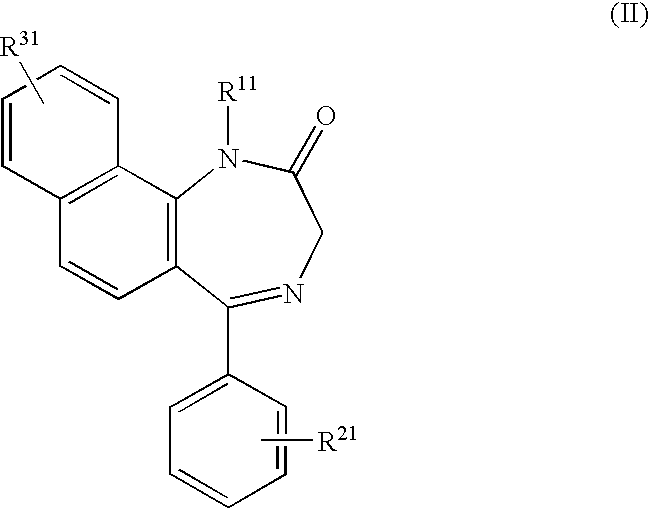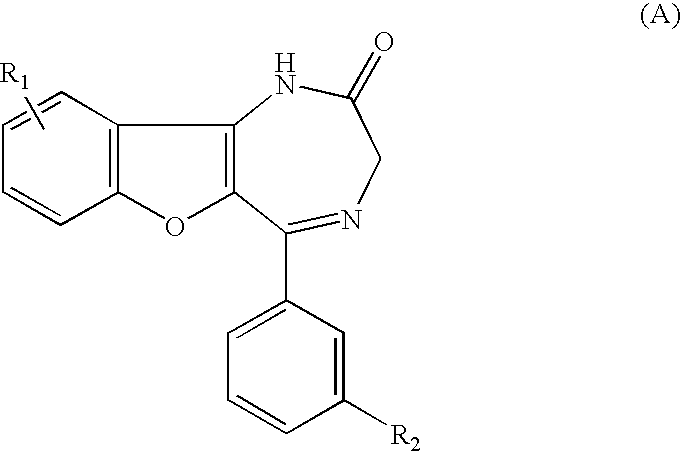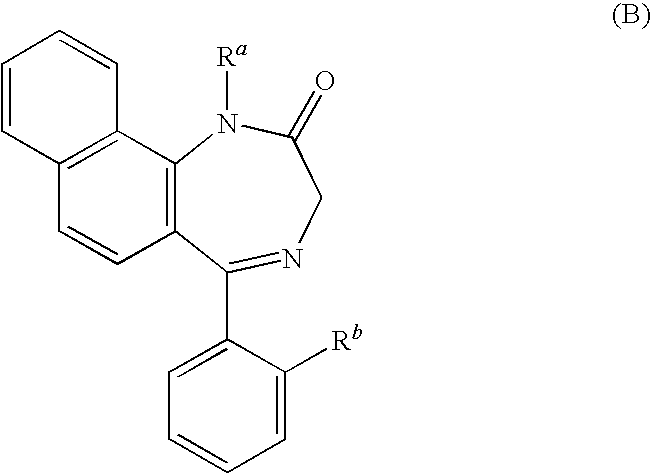P2x4 receptor antagonist
a p2x4 receptor and antagonist technology, applied in the direction of anti-inflammatory agents, biocide, drug compositions, etc., can solve the problem of no other way of pharmacotherapy, and achieve excellent p2x4 receptor antagonism and stable expression
- Summary
- Abstract
- Description
- Claims
- Application Information
AI Technical Summary
Benefits of technology
Problems solved by technology
Method used
Image
Examples
example 1
5-(3-Methoxyphenyl)-1,3-dihydro-2H-naptho-[1,2-e]-1,4-diazepin-2-one
(1) 1-Amino-2-(3-methoxybenzoyl)naphthalene
[0095]A solution of 1-amino-2-naphthonitrile (1.00 g, 5.95 mmol) in anhydrous ether (20 mL) was dropwise added to a solution of 1M 3-methoxyphenylmagnesium bromide-tetrahydrofuran solution (17.8 mL, 17.8 mmol) for 10 minutes. The mixture was heated under reflux for one hour. The reaction mixture was poured into 2N hydrochloric acid (30 mL). After addition of methanol (5 mL), the mixture was stirred for 4 hours at room temperature. The mixture was neutralized by addition of potassium carbonate, and the neutralized ether was subjected to extraction with ether. The ether portion was washed with saturated brine and dried over anhydrous sodium sulfate. The dried mixture was placed under reduced pressure to distill the solvent off. The residue was purified by silica gel column chromatography (chloroform / hexane-4 / 1), to give the titled compound (1.54 g, yield 93%).
[0096]1H NMR (CD...
example 2
5-(3-Hydroxyphenyl)-1,3-dihydro-2H-naptho-[1,2-e]-1,4-diazepin-2-one
[0103]To a solution of 5-(3-methoxyphenyl)-1,3-dihydro-2H-naptho[1,2-e]-1,4-diazepin-2-one (300 mg, 0.948 mmol) in anhydrous dichloromethane (9 mL) was added 1M boron tribromide-dichloromethane solution (1.9 mL, 1.90 mmol) under cooling with ice. The mixture was stirred over-night at room temperature. The reaction mixture was poured into saturated aqueous sodium hydrogen carbonate solution. After addition of chloroform, the mixture was stirred for 10 minutes at room temperature. An insoluble crystalline product was filtered off. The solution was subjected to extraction with chloroform. The organic portion was dried over anhydrous sodium sulfate and placed under reduced pressure to distill the solvent off. The residue was combined with the filtered crystalline product and purified by silica gel column chromatography (chloroform / methanol-96 / 4). The purified crystalline product was suspended in ethyl acetate (4 mL). Th...
example 3
5-(4-Methoxyphenyl)-1,3-dihydro-2H-naptho-[1,2-e]-1,4-diazepin-2-one
[0107]The following intermediate compound and target compound were prepared by performing procedures similar to the procedures of Example 1.
(1) 1-Amino-2-(4-methoxybenzoyl)naphthalene
[0108]1H NMR (CDCl3, 500 MHz) δ: 3.89 (3H, s), 6.9-7.0 (2H, m), 7.01 (1H, d, J=8 Hz), 7.2-7.5 (2H, m), 7.5-7.6 (1H, m), 7.6-7.7 (2H, m), 7.75 (1H, d, J=8 Hz), 7.96 (1H, d, J=8 Hz).
(2) 2-Cloro-N-[2-(4-methoxybenzoyl)naphthalen-1-yl]acetamide
[0109]1H NMR (CDCl3, 500 MHz) δ: 3.88 (3H, s), 4.14 (2H, s), 6.9-7.0 (2H, m), 7.51 (1H, d, J=8 Hz), 7.6-7.7 (2H, m), 7.8-7.9 (3H, m), 7.9-8.0 (2H, m), 9.30 (1H, br s).
(3) 5-(4-Methoxyphenyl)-1,3-dihydro-2H-naptho[1,2-e]-1,4-diazepin-2-one
[0110]1H NMR (DMSO-d6, 400 MHz) δ: 3.75 (1H, d, 3-10 Hz), 3.81 (3H, s), 4.53 (1H, d, J=10 Hz), 6.99 (2H, d, J=9 Hz), 7.29 (1H, d, J=9 Hz), 7.50 (2H, d, J=9 Hz), 7.6-7.8 (3H, m), 8.0-8.1 (1H, m), 8.3-8.4 (1H, m), 10.79 (1H, s).
PUM
| Property | Measurement | Unit |
|---|---|---|
| temperature | aaaaa | aaaaa |
| optically active | aaaaa | aaaaa |
| temperature | aaaaa | aaaaa |
Abstract
Description
Claims
Application Information
 Login to View More
Login to View More - R&D
- Intellectual Property
- Life Sciences
- Materials
- Tech Scout
- Unparalleled Data Quality
- Higher Quality Content
- 60% Fewer Hallucinations
Browse by: Latest US Patents, China's latest patents, Technical Efficacy Thesaurus, Application Domain, Technology Topic, Popular Technical Reports.
© 2025 PatSnap. All rights reserved.Legal|Privacy policy|Modern Slavery Act Transparency Statement|Sitemap|About US| Contact US: help@patsnap.com



